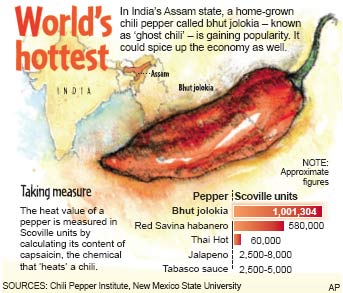
New varieties of “superhots” provide near-death experiences in a bowl of guacamole. Photograph by Grant Cornett.
In mid-December of 2011, Brady Bennett went out drinking at Adobe Gila’s at the Greene, a Mexican restaurant in Dayton, Ohio. After two beers, the bartender offered him a free shot. Bennett chose Patrón tequila with apple schnapps. Soon, he recalled, his throat began to swell. He struggled to breathe, and his nose, mouth, and lungs “felt as though they were on fire.” He called for an ambulance, moaning, and was taken to the hospital. A year later, Bennett filed a lawsuit against Adobe Gila’s, claiming that the bartender had spiked his drink with extract of the bhut jolokia, or ghost chili. (Adobe Gila’s denies the allegations.) “It wasn’t as if they gave him a little Tabasco,” Jeff McQuiston, Bennett’s lawyer, told the Dayton Daily News. “This stuff is lethal.” The bhut jolokia is a hundred and fifty times hotter than a jalapeño. Gastromasochists have likened it to molten lava, burning needles, and “the tip of my tongue being branded by a fine point of heated steel.” Yet, at more than a million Scoville heat units—the Scoville scale, developed by the pharmacist Wilbur Scoville in 1912, measures the pungency of foods—the bhut jolokia is at least 462,400 SHU short of being the world’s hottest chili pepper.
“Chili pepper” is a confusing term, another of Christopher Columbus’s deathless misnomers. (Columbus and his men classified the spicy plant they had heard being referred to in Hispaniola as aji—farther north, in Mexico, it was known by the Nahuatl word chilli—as a relative of black pepper.) Chilis belong to Capsicum, a genus of the nightshade family. Horticulturists consider them fruits, and grocers stock them near the limes and cilantro. Most chilis contain capsaicin, an alkaloid compound that binds to pain receptors on the tongue, producing a sensation of burning. Sweet banana peppers are usually neutral. Pepperoncini (approximately 300 SHU) produce just a flicker of heat, while cayennes (40,000) are to Scotch bonnets (200,000) as matches are to blowtorches. Capsaicin is meant to deter predators, but for humans it can be too little of a bad thing. Because capsaicin causes the body to release endorphins, acting as a sort of neural fire hose, many people experience chilis as the ideal fulcrum of pain and pleasure.
In recent years, “superhots”—chilis that score above 500,000 on the Scoville scale—have consumed the attention of chiliheads, who debate grow lights on Facebook (“You can overwinter with a few well-placed T-8s”), swap seeds in flat-rate boxes (Australian customs is their nemesis), and show up in droves at fiery-foods events (wares range from Kiss My Bhut hot sauce to Vanilla Heat coffee creamer). Chilis, in general, are beautiful. There is a reason no one makes Christmas lights in the shape of rutabagas. Superhots come in the brightest colors and the craziest shapes. Their names, evoking travel and conquest—Armageddon, Borg 9, Naga Morich, Brain Strain—sound as though they were made up by the evil twins of the people who brand body lotions. Trinidad 7-Pots are so called because it’s said that one of them is enough to season seven pots of stew.
Like computers, superhots are evolving at a rate that embarrasses the phenomena of just a few years ago. In 1992, Jane and Michael Stern observed, in this magazine, that five thousand Scoville units “would be considered very hot by most people, but even that is piddling compared with the blistering fury of the habanero pepper, which can reach three hundred thousand.” (The Scoville test originally measured how many drops of sugar water it would take to dilute the heat of a chili; pungency is now determined more reliably by high-performance liquid chromatography, whose results can still be reported in Scoville units.) From 1994 to 2007, the Red Savina—a scarlet, heart-shaped pod rating 570,000 SHU—held the Guinness World Record for hottest chili pepper. Then the bhut jolokia, the existence of which had been whispered about for years among chiliheads, as though it were a vegetable Loch Ness monster, surfaced on the international scene. In 2000, R. K. R. Singh, a scientist at a Ministry of Defense research laboratory in Assam, India, where the bhut jolokia is widely grown, submitted some samples for analysis. The test results, which indicated that it was significantly more powerful than the Red Savina, made their way to Paul Bosland, a professor of horticulture and former sauerkraut expert who, for the past twenty-two years, has run the Chile Pepper Institute, at New Mexico State University. Bosland was skeptical of the Indian scientists’ numbers, but he managed to obtain some bhut jolokia seeds, which he grew into plants. In January of 2007, he filed with Guinness, which awarded the C.P.I.’s bhut jolokia (1,001,300 SHU) the new world record.
In February of 2011, Guinness confirmed that the Infinity chili, grown in Lincolnshire, England, by a former R.A.F. security guard, had surpassed the bhut jolokia by more than sixty-five thousand SHU. Only two weeks later, a Cumbrian farmer named Gerald Fowler introduced the Naga Viper. At 1,382,118 SHU, it was, Fowler said, “hot enough to strip paint.” He told reporters, “We’re absolutely, absolutely chuffed. Everyone complains about the weather and rain here in Cumbria, but we think it helped us breed the hottest chili.” He posed for the Daily Mailwearing a sombrero.
Chiliheads are mostly American, British, and Australian guys. (There is also a valiant Scandinavian contingent.) Chili growing is to gardening as grilling is to cooking, allowing men to enter, and dominate, a domestic sphere without sacrificing their bluster. “I can’t remember eating anything spicy before the parrot came along,” Fowler, a big man with a brushy mustache, told me, in July. The chili world is full of garrulous, confiding, erratic narrators who say things like “before the parrot came along.” In Fowler’s case, the parrot belonged to his father’s brother. “Uncle Jim wanted another parrot, and his wife said, ‘Nope, you’ve got a parrot, and that’s it.’ So he made up this story that my dad wanted a parrot, and next time he visited us he brought one.” The parrot, named Murphy, came with a chili plant. (Birds can’t taste capsaicin.) Fowler quit fishing and started growing habaneros in his bedroom. Soon, he had left his job as a Web designer and founded the Chili Pepper Company, through which he sells seeds, sauces, powders, and products such as Kiss the Devil, a mouth spray made with chili-infused alcohol. “You can have just a little bit before you go to the gym, to get your endorphins up,” Fowler told me.


No comments:
Post a Comment